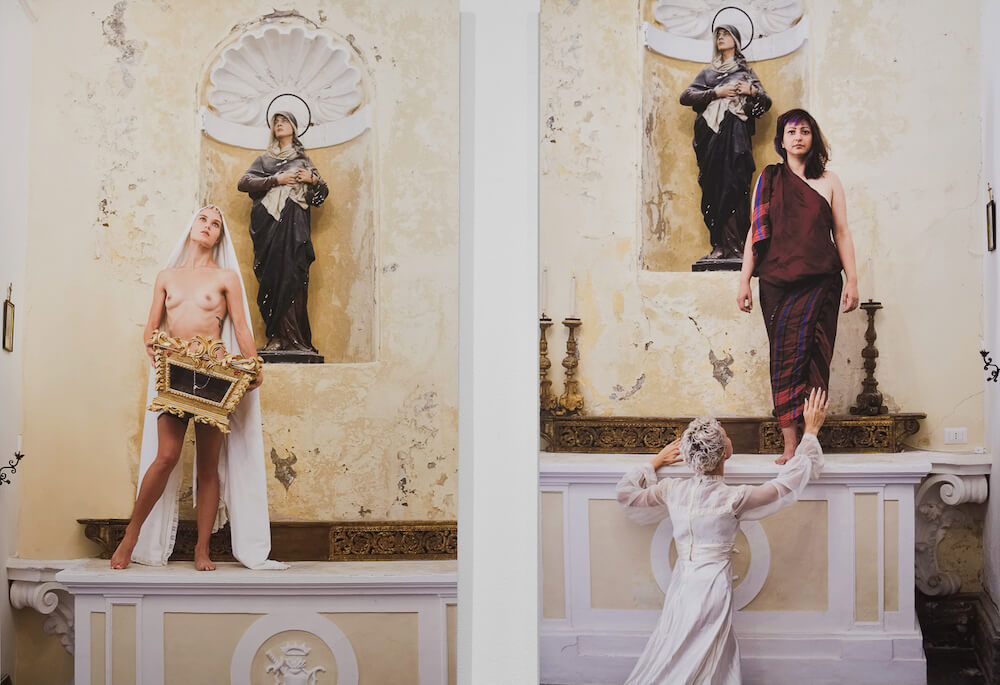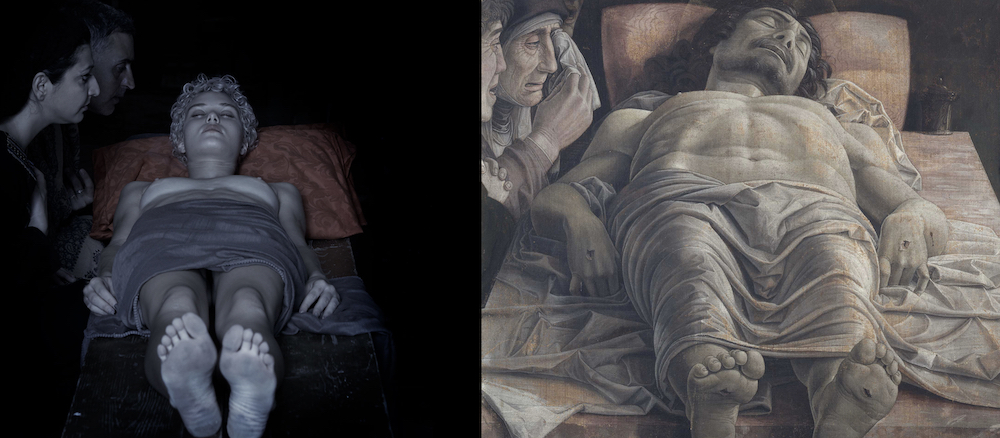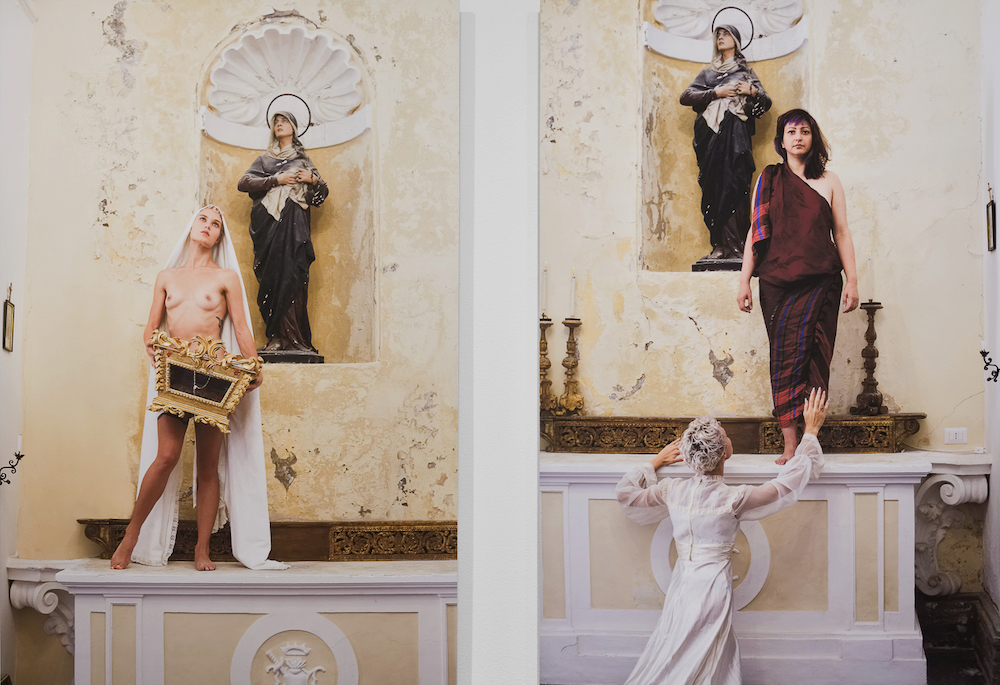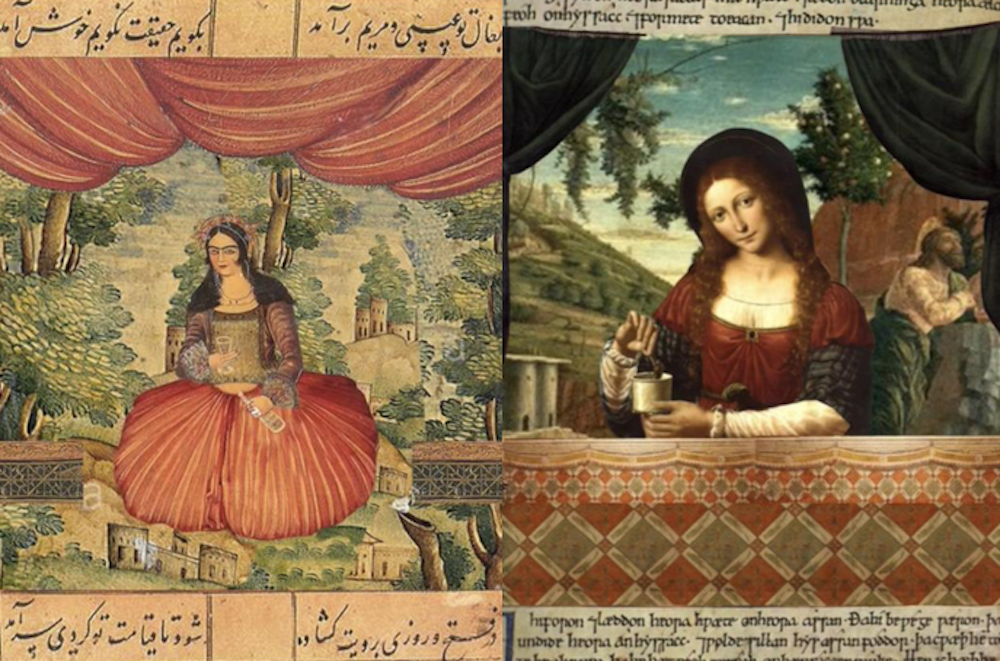Renaissance Reimagined, Reignited: Negin Sharifzadeh

Negin Sharifzadeh’s recent photographs, sculptures and animations challenge the eternal Feminine in the history of Renaissance art to reinterpret and represent Middle Eastern histories. Her recent solo exhibition at A.I.R. Gallery in Brooklyn, NY was inspired by a residency at the Santa Maria a Rignana church in Italy, where she inserted non-binary perspectives to the artistic, political and cultural hierarchies between the East and West. Negin spoke with FRONTRUNNER about connecting the contradictions using sharp and critical irony and humor in her theatrical reenactments.
This series of photos were created during a residency at Santa Maria a Rignana: a decommissioned church in which all the church sculptures, fabrics, and ornaments had been left intact. Did you expect the space to have such a directive impact on your work?
Not at the beginning, but waking up everyday and inhabiting such a working space, I became more and more curious about the history of these artifacts and the history of this former. I was even provided with the papers and archival documents of the church dating back to World War II. Learning more about the church and the local history of the village, made me realize how much there is that I don’t know about this glorious history of the Renaissance. You always get exposed to the mainstream of any movement of art, politics and social evolution in the academic setting of a studio program, unless you delve into it more deeply on your own. This Residency program was the spark of gaining a fuller contextual understanding of the history and helping me sketch out lots of ideas and projects around this theme. I made several stop-motion animated sketches and staged photographs using artifacts from the church, that directly informed the show.

Black Night (2019)
Mounted museum print (1 of 3)
19.7″ x 16.3″
Alongside, Andrea Mantegna’s Cristo Morto (1480)
What were some of your considerations in the compositions? Did you always start with a Renaissance reference? Sometimes they are literal recreation of a scene or abstracted.
Some are direct reenactments of famous Italian Renaissance painting, such as Cristo Morto – Lamentation of Christ – by Andrea Mantegna. Some are not reenactments, but close enough to the reference that you can guess the reference while including a twist either conceptually, or in terms of the objects inhabiting the paintings’ frame.
The Virgin Annunciate, by Antonello Da Messina. The Annunciation, by Fra Angelico. The graces of La Primavera – Spring, by Sandro Botticelli. A few are inspired by the subject matter and formats of renaissance paintings in general, but not based on a particular work.
What is your creative relationship with the model in this series Bryn Gast? Her presence is directive and connected and seems like a collaboration developed.
Bryn Gast is an ongoing collaborator and performer in my works. By now, we work smoothly together. She is a recent graduate of English literature from Emory University and has worked in theatre, modelling and photography for a while now. She brings an interesting view to my projects. Given our distinct looks, it made it easier for me to use our juxtaposition to manoeuvre around the idea of otherness.

Growing Brighter Futures (Diptych) (2019)
Mounted museum print (1 of 3)
40.5” x 27”
I also notice that Bryn’s eye contact is soft and distant, unfocused in her characters, and yours is direct, sharp and clear. Was this intentional?
Yes, as the other in this process of interrogating this simplistic view of dividing the world into “East” and “West,” I put myself more directly in confrontation with the viewer. This is implicit, in my playing the role of Jesus and Mary, for instance. But also carried over to the gestural and explicit in my direct stare into the camera, and the eyes of the viewer.
I am challenging this reductionist, binary view of the world. The separateness of East and West has always been a fiction, and is increasingly being used for political advantage by rising Nativist-Right political forces around the world. The end result of this narrative is the intended extinction of the East, physically, culturally, artistically and historically. The idea of this extinction becomes meaningless when you understand the continuity and interconnectedness between cultures. Bryn’s gestures are distant, unfocused look takes us back to the original paintings and time frame of the 15th and 16th centuries. Her looks are remote, distant, and far from the here and now. My direct gaze incorporates the contemporary artist using these forms to challenge the audience’s conceptions.
How does it feel to insert yourself in the Eurocentric histories? Can you explain the elements of your Middle Eastern background that you re-contextualized?
I enjoyed the process of inhabiting these iconic works, and taking on the role of the narrator. These are not the traditions I was raised, in Iran, but they are the pillars of the art I came to study later, so breaking with the otherness that was assigned to me in relation to this history was liberating. It was also interesting diving into this history to feel the similarities between Islam and Catholicism, in terms of relics and saints, prophets and sacred texts. In terms of references to my cultural background, I made the hints subtle. Using clothing and fabrics specifically with prominent Persian patterns. Also, fabrics from Iran which are for daily use but in my photos appear as formal garments, emphasizing how everyday objects can gain importance given the context they’re in. Or a style of make up. So the elements are really subtext rather than part of the frontal visual dialogue within the pieces.

The Weaving Angel of Annunciation (2019)
Mounted museum print
20” x 20” (1 of 3)
Alongside, Antonello da Messina’s Annunciata di Palermo (1476)
How can we as an “art world” and “culture” do more to challenge the hierarchies of art history narratives and the otherness experienced by cultural narratives that are minimized?
As artists it is in our power to question and critique the way our very own visual and cultural histories have been narrated, written, reenacted and screened. It is important to look back to edit and reclaim our very own visual, cultural and historical representations. We are part of the process of making these narratives, so our reclamation and rewriting is part of the process of building ideological frameworks and assumptions. In my view, for artists, research is an important part of their process of making work. I don’t agree that because I’m an artist I’m allowed to play with any image without the knowledge of its origin, or use it in any context, unless there is a solid reason for it. Within the artist freedom there also comes the question of origin, history and context. With freedom comes greater sense of responsibility.
The art world, writ large, has a lot of work to do. Too often, institutions of art are dependent on, and draw their legitimacy from, existing hierarchies of wealth and power. So they tend to replicate them. That’s where the money is. The fame. The access to exposure, so it is natural. But the institutions that make up the art world—galleries, academic, critics, journals, etc.—need to step up and explicitly challenge the hierarchical norms of both art history/theory and the functioning of art as a market. This means making more room for women, people of color, LGBTQIA folks, Indigenous voices, in speaking about, and the creation of art.
I believe this is critical to not only making the art world more just in and of itself, but in helping society at large create a new narrative.
Can you talk about the direct comparisons of historical artworks in the GIF series, for example “Same but Different”?
In Same but Different Worlds, I used the format of animated Gifs to make a quick, artistic and humorous comparison between the Persian miniature and Italian Renaissance paintings of 16th and 17th centuries. While the paintings’ styles originated from different roots, there are lots of similarities in the composition of the work, the subject matter, and the themes, like Mary and Child. The attention to the detailed interiors in both styles, women as the subject matter, using landscape as the background, the importance of using text as part of the visual storytelling. The animations served as an entree to the show, a quick visual introduction to the themes I was grappling with.
Are the GIF’s a format you explore more playful and humorously?
Absolutely! I wanted to appeal to all generations and use humor as a tool to arouse curiosity in my audiences of all ages. Humor has a way of disarming the viewers gaze, and allowing new perception to break through. It’s also important to me that the work and the concepts are made accessible and immediate to my audience and the general public. My aim is not to make art for only a specific group of people, the elite, it is for all people and our public. As it is all of us from all walks of life that create our collective past, as history itself.

Same, But Different Worlds (2019)
Single Channel, 2D GIF Animation, 1080 x 1920
Do you plan on expanding this series?
Yes, this show emerged organically from the research that began during the residency. I am pleased with how the work developed, but feel that it is really the beginning of an exploration of these themes, not the end. For the next round, I am planning to shift my emphasis to the Ottoman, rather than the Persian, empire, as the level of cross-influence and inter-penetration is more explicit and deeper. That is the fun of creating. You know where you are starting from, you pick a direction, but you can’t predict the detours and interruptions that will determine the final destination.








